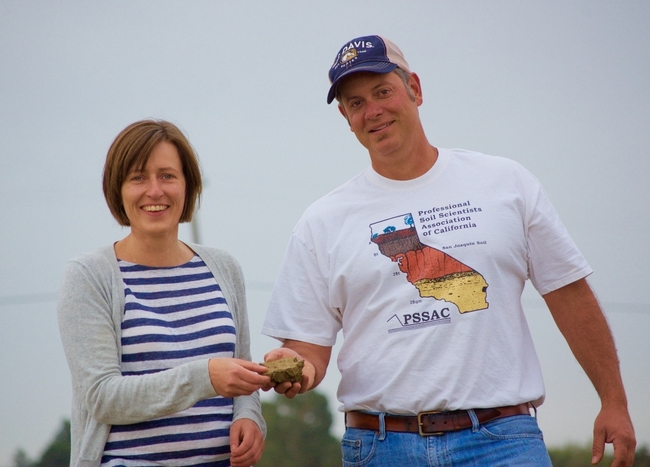
The article included a map of California with color coded areas indicating areas that were excellent for groundwater banking down to poor. The story was picked up widely by the news media.
California farmers will intentionally flood their fields this winter
Jane Braxton Little, Scientific American
For two months this winter, a team of scientists will flood almond orchards in the Central Valley to a depth of two feet by redirecting rainfall through a network of ditches originally designed to divert floodwater away. To measure success, they will then monitor how much water filters into the water table over the course of two years. If the method pans out, pear, plum and walnut tree orchards might also benefit from intentional flooding, according to a recent study led by UC ANR Cooperative Extension specialist Anthony O'Geen.
Map identifies farmland with greatest potential for groundwater recharge
Diane Nelson, UC Davis News Service
This December, O'Geen and a team of scientists - including Helen Dahlke, professor in integrated hydrologic sciences at UC Davis - will flood almond fields in the Central Valley, building on research that suggests that deliberately flooding farmland in winter can replenish aquifers without harming crops or drinking water. “Adding an extra few feet of water to even just 10 percent of California's cropland this winter could add an additional 3 million acre-feet of groundwater,” Dahlke said. “That could go a long way toward replenishing the 6 million acre-feet growers had to pump this year alone to cope with California's drought.”
UC scientists test inexpensive way to capture El Niño rains
Amy Graff, The San Francisco Chronicle (SFGate.com)
Researchers from UC Davis and UC Cooperative Extension are testing a new method for capturing some of that underutilized water by diverting it from rivers into the network of canals running through Central Valley farmland. "That could go a long way toward replenishing the 6 million acre-feet growers had to pump this year alone to cope with California's drought," said Dahlke, who's testing the technique in the field. UC ANR Cooperative Extension specialist O'Geen points out that this is a win-win for agriculture. "They're typically considered the bad guys. They're feeding the world yet they're considered the water hogs because they have to take all the water to grow the food. On-farm recharge offers the opportunity for them to offer two services — providing food and collecting water. That puts agriculture in a better light."
How California could get smarter about droughts and flooding
Nathaneal Johnson, Grist.org
Land suitable for flooding should be flat, free of contamination and clear of structures. O'Geen estimates that leaves 3.6 million acres. “A preliminary calculation based only on soil properties and crop type shows that landscapes rated Excellent or Good could be used to bank as much as 1.2 million acre feet of water per day.” UC ANR groundwater hydrologist Thomas Harter was also a source in the article. He said there are additional challenges to overcome, including reluctant farmers, variations in soil profile, red tape and a lack of infrastructure, especially on farms that now use micro sprinklers or drip irrigation systems, rather than flood.
California farmers hope to capture El Niño rains
David Dienick, KCRA 3 News
Researchers have been looking for ways to capture more runoff without relying on reservoirs. "We've never actually managed our agriculture landscapes for groundwater recharge to my knowledge," O'Geen said.
Farmers urged to flood their fields with any upcoming rain
KFBK News Radio
A soil map has been developed that will allow farmers to take advantage of every opportunity to recharge the groundwater. "Is it a managed event where we are giving a couple extra irrigations in the winter time and the wet crops can tolerate a few extra irrigations when they don't really use the water," O'Geen said.
Another study suggests flooding farmland to recharge aquifers
Tim Hearden, Capital Press
A study in Merced, Madera and Fresno counties will determine whether diverting excess river flows from winter storms to farmland successfully. In addition, O'Geen and Dahlke plan to use some of the state's 3.6 million acres of farms and ranches with suitable topography and soil conditions to recharge aquifers during winter months. Dahlke is still conducting field experiments to evaluate how much water can be recharged in a couple of weeks.
UC maps farmland that can 'bank' groundwater during El Niño rains
KPCC 89.3
In response to California's withering drought and a dwindling water supply, researchers at UC Davis have identified farmland that could potentially "bank" groundwater during what is predicted to be an unusually wet winter. "A lot of growers are interested in learning how they can help improve the groundwater situation in California," O'Geen said. "The index provides details on the groundwater-recharge potential for any parcel, which you can search for by address or access using your device's GPS."